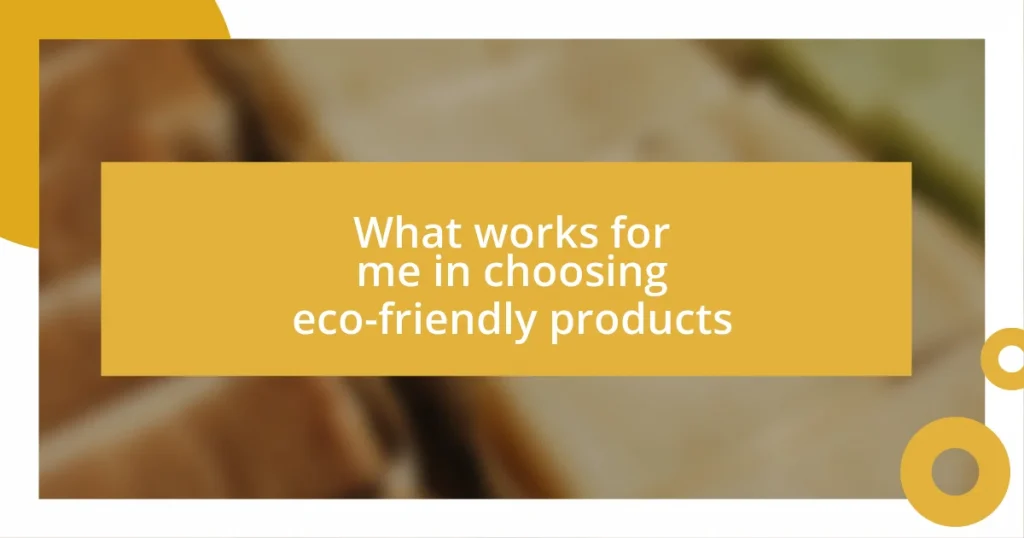Key takeaways:
- Ethical consumption involves making informed choices that align with personal values, focusing on sustainability, fair labor practices, and understanding the story behind products.
- Identifying ethical brands is facilitated by checking for certifications, understanding company values, and engaging with community efforts to establish meaningful connections.
- Sharing knowledge and experiences within the community enhances commitment to ethical consumption, as discussions and collaborations can inspire collective action towards sustainable practices.

Understanding ethical consumption
Ethical consumption is more than just a trend; it’s about making thoughtful choices that align with our values. I still remember the first time I consciously chose to buy from a local farmer’s market instead of a big grocery store. The feeling of connecting with the source of my food was empowering—like I was casting a vote for the kind of world I wanted to live in.
One of the key elements of ethical consumption is sustainability. It’s all about choosing products that minimize harm to the environment and promote fair labor practices. I often find myself asking: how did this item come to be in my hands? This reflective question has driven me to research brands deeply, steering away from companies that prioritize profit over people and planet.
As I navigated this journey, I encountered moments that painted a vivid picture of the impact of my choices. For instance, discovering that a tee I loved came from a factory with subpar working conditions was eye-opening. It instilled a sense of responsibility in me; every purchase is a story. How much more mindful could we be if we all understood the narrative behind the products we choose?

Identifying ethical brands
Identifying ethical brands can feel like navigating a maze, but I’ve found a few reliable techniques to make this process easier. One of my go-to strategies is checking for certifications like Fair Trade or B Corp, which indicate that a brand meets specific social and environmental standards. I remember visiting a local store that proudly displayed its Fair Trade certification. The owner shared how their bananas were sourced directly from farmers, and the joy of knowing my purchase helped support their livelihoods was a rewarding realization.
To further assist in identifying ethical brands, here are some key points to consider:
- Research Company Values: Look for brands that explicitly state their mission and values, focusing on sustainability and social responsibility.
- Transparency in Supply Chain: Ethical brands often share information about their sourcing and production processes.
- Third-party Certifications: Seek out certifications like Fair Trade, Global Organic Textile Standard (GOTS), or Carbon Neutral, which signify adherence to ethical practices.
- Community Involvement: Brands that actively participate in their communities tend to be more committed to ethical practices.
- Consumer Reviews and Experiences: Check online reviews or social media to see how others perceive the brand’s ethical stance.
Taking these steps turned choosing where to shop into a more meaningful experience for me, deepening my connection not just to the products, but also to the people behind them. Each ethical brand I discover feels less like a transaction and more like a partnership in creating a better world.

Evaluating product sustainability
Evaluating product sustainability requires a keen eye and an understanding of what makes a product truly sustainable. I often find myself on a quest to discern the life cycle of the items I consider purchasing. For instance, I once hesitated before buying a beautiful, organic cotton shirt when I learned that the dyeing process wasn’t environmentally friendly, even if the fabric was sourced sustainably. This moment reminded me of my responsibility as a consumer; sustainability isn’t just about materials but also the processes involved.
What often surprises me is how brands can misrepresent their sustainability efforts. I recall a time when I was drawn to a beautiful bamboo toothbrush, only to discover later that the methods used to produce it contributed to deforestation. It’s easy to take claims at face value, but I’ve learned that digging a little deeper is essential. I now check if the product has certifications that validate its environmental claims, such as the Forest Stewardship Council (FSC) seal for wood products.
In my experience, assessing a product’s sustainability isn’t always straightforward. It requires both research and intuition. I’ve developed a checklist that I run through mentally—Does the product have credible certifications? What do the reviews say about its impact? Each question fuels my understanding. Sustainability means more than just checking off boxes; it’s an evolving journey where every informed decision brings me closer to aligning my purchases with my values.
| Criteria | Questions to Ask |
|---|---|
| Materials | Are the materials sustainably sourced? |
| Production Process | What’s the environmental impact of making this product? |
| Certifications | Does it have credible sustainability certifications? |
| Community Impact | How does this product affect the local community? |

Making informed purchasing decisions
When it comes to making informed purchasing decisions, I’ve learned that it’s not just about what you buy, but why you buy it. I remember standing in the aisle, staring at two products that seemed nearly identical. One claimed to be environmentally friendly, while the other was more affordable. That moment prompted me to ask: “Is saving a few bucks worth it if I’m supporting unsustainable practices?” It made me realize the importance of understanding the broader impact of my choices.
I often turn to brand narratives to guide my decisions. For example, I stumbled across a company that not only used recycled materials but also shared powerful stories of how their products helped clean up local oceans. This connection turned my purchase from an everyday chore into a contribution to a cause I deeply care about. By seeking out brands that align with my values, I feel empowered—like I’m part of a larger community striving for positive change.
It’s pivotal to be aware of common marketing tactics that may obscure the truth. I once found a “green” cleaning product that looked appealing on the shelf, but a closer inspection revealed vague ingredients and no certification to back its claims. I felt a mix of frustration and clarity, realizing that being informed includes looking past attractive packaging and catchy slogans. How often do we make purchases based on superficial appearances without digging deeper? By taking that extra step to research, we not only safeguard our values but also encourage brands to be more transparent.

Adopting minimalism in lifestyle
Embracing minimalism has transformed my approach to consumption. I vividly recall the day I decided to declutter my living space. As I removed items I hadn’t used in years, I felt a wave of lightness wash over me. Each piece I let go of revealed how much I had accumulated out of habit rather than need. It was liberating and made me question: How many of these items genuinely add value to my life?
As I shifted towards a minimalist lifestyle, I started to evaluate my purchases through a new lens. Instead of filling my closet with trendy items, I began seeking quality over quantity. I remember investing in a timeless leather wallet that’s only gotten better with age. Every time I pull it out, I feel a connection to both the craftsmanship and the decision I made to prioritize something lasting and meaningful—rather than succumbing to the constant cycle of fast fashion.
The beauty of minimalism lies in its ability to simplify choices. I’ve found that having fewer options actually enriches my life. For instance, with only a handful of books on my shelf, I’ve developed a deeper bond with each one. I can clearly recall my excitement as I dove into a well-loved novel rather than feeling overwhelmed by a sea of unread spines. This philosophy extends beyond my possessions; it encourages me to question: What truly matters in my life, and how can I cultivate space for those priorities?

Engaging in local communities
Engaging with local communities has been a game changer in my journey towards ethical consumption. I vividly recall attending a farmers’ market for the first time. As I walked through the stalls, surrounded by vibrant fruits and vegetables, I struck up conversations with the farmers about their growing practices. Hearing their stories made me realize that every dollar I spent there supported not just their livelihoods but also sustainable agriculture. How often do we consider the faces behind our food?
I’ve found that volunteering locally is another deeply rewarding way to connect with my community. Last year, I participated in a river cleanup organized by a nearby environmental group. It was incredible to see neighbors come together, united by a shared purpose. The experience opened my eyes to the impact of collective action and strengthened my belief that when we engage with our communities, we amplify our efforts toward a greater cause. What would our neighborhoods look like if everyone contributed their time and skills?
Building relationships with local businesses has also enriched my ethical consumption practices. I remember visiting a small bookstore that not only stocked ethically produced goods but also hosted community events. After attending one of their book readings, I started to develop friendships with fellow patrons who shared my values. This sense of belonging fostered my commitment to support local initiatives. I often ask myself: How can we create meaningful connections that go beyond transactions? For me, the answer lies in engaging with the fabric of my community.

Sharing knowledge and experiences
Sharing knowledge and experiences in ethical consumption has significantly enriched my perspective. I remember attending a workshop on sustainable living where participants shared their journeys toward making conscious choices. The stories varied—some focused on reducing plastic use while others explored plant-based diets. I found myself nodding along, feeling that sense of camaraderie that comes from knowing we’re all navigating this path together. Doesn’t it feel good to realize that no one is alone in their quest for a more sustainable lifestyle?
One pivotal moment for me was when a friend organized a clothing swap party. As we sifted through pieces from each other’s wardrobes, the conversations flowed effortlessly. We shared tips on upcycling, discussed where to find ethical brands, and laughed over fashion faux pas. Each garment had a story, and it made me appreciate the journey of each item we held. How often do we think about the life each piece of clothing has led before it becomes part of our wardrobe?
Looking back, I realize that these shared experiences have not only educated me but also deepened my commitment to ethical consumption. For instance, after learning about the impact of fast fashion on workers in developing countries, I started advocating for fair-trade alternatives. Engaging in discussions and sharing resources with others amplifies my efforts and inspires those around me to think critically about their purchases. Isn’t it powerful to think that through simple conversations, we can collectively shift our consumer habits?















